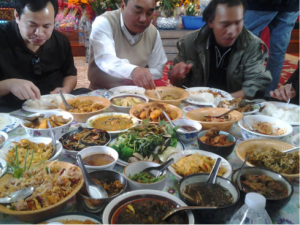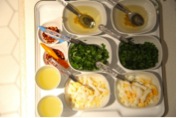After decades of isolation, Myanmar is finally coming in from the cold. But how much do we know about the Land of Pagodas? A conversation with Anglo-Burmese chef Debbie Riehl sheds light on the country’s culinary tradition.
When it comes to Myanmar, there are two revolutions currently underway: one is taking place inside the country, which is gradually embracing democracy after decades of military rule and international isolation.
The other revolution is sizzling miles away, in London, where artist-cum-chef Debbie Riehl is initiating an increasing number of people to the joys of Burmese cuisine. Her goal, as she puts it, is “to place Burmese food on the glorious food map of Britain.”
To accomplish her mission, Debbie has set up Hushhushdining, a pop-up restaurant that she has been running since 2012.
For those who are not in on this new craze, pop-up restaurants are temporary eateries that are only available for a few nights. This means that owners do not have the operating costs that come with running a restaurant and can hold their events in different venues each time. A variation on the theme of pop-up restaurants are supper clubs. These are more like dinner parties and usually take place at the cook’s house.
Debbie doesn’t seem to be the only food lover that has gone down this route: her pop-up is part of a wider culinary trend that is spreading like wildfire in some of the world’s biggest cities, from London to Los Angeles.
Hushhushdining is definitely plugging a hole in the Western culinary scene, where Burmese food is conspicuous by its absence: “There is only one Burmese restaurant in the whole of Europe”, she points out. “It’s called Mandalay. The food is good, and it’s more a café style than a restaurant.”
Born in Myanmar in the late ‘50s, Debbie arrived in Britain when she was five. Not speaking Burmese herself, food is a way for her to treasure and maintain her cultural heritage. Her parents, she tells me, attached great importance to traditional Burmese food, which she says “represents a very important link with my background.”
The idea of setting up her own pop-up restaurant came to her a few years ago, when she approached a cookery school asking them if they had ever had Burmese food. “To which they, like most people, replied no”, she explains. “Therefore I took along a sample for them to taste, they loved it and subsequently said I could showcase my Burmese food to their students. The students loved the food, of course (!) and I went on to demonstrate further classes.”
It doesn’t come as a surprise then that Debbie’s endeavour has been met with success. All her events for this year have been fully booked, as is her next supper club in September. “But I have two pop-ups in London soon,” she reassures me, “at Asia House (25 September) and at The Hilton – Trader Vic’s Restaurant (10 October).”
Among her guests are plenty of Burmese people, which is definitely a sign that her food is authentic. “I have had many Burmese people come to my events who are not only thrilled to be eating Burmese food but are really excited about what I’m trying to achieve, to put Burmese food on the food spectrum of British foods.”
However, it is not only members of the Burmese expat community that sign up to taste her recipes: “Many different people come to my events from all walks of life and backgrounds,” she explains. And many more are likely to ride the Burmese wave as the country opens up to the rest of the world.
“I think there is already a growing interest in all things Burmese”, Debbie says. “Burma is one of the top tourist destinations this year!”
Come dine with Debbie
So what does an every-day Burmese meal look like? “Typically, Burmese food is eaten simultaneously: soups, salads, curries, noodles, rice, relishes, dips, etc.”, Debbie reveals.
“And the food is eaten with the hand, the right hand”, she adds, running me through some of Myanmar’s dining rituals. “The eldest help themselves first and, after that, everyone helps themselves to whatever combination of food they’d like.”
The fact that food is not served in courses allows for more creativity, as everyone devises their own dishes and combination of flavours. And creativity is one of the distinctive traits of Debbie’s food.
Asked how close her recipes are to traditional Burmese cuisine, Debbie replies that, while being essentially Burmese, her food is presented in a contemporary way. “Being an artist,” she explains, “the aesthetics are very important to me.”
“I also serve it in a Western way, with various courses unlike the traditional way of serving everything at once”, she adds.
An example of her Burmese food with a personal touch is her Htamane, a traditional rice snack, which she has reinvented by adding a medley of mango and mint.
“Burmese don’t cook many puddings,” she adds, “so I create puddings that are a hybrid, that is, puddings that have elements of typical Burmese ingredients such as coconut, mango, coriander.”
Striking a balance between the past and the contemporary is not easy, and this is not only a challenge for Debbie, but also for her country of origin: “It is important to maintain the ‘Burmese-ness’ of all things Burmese”, she says. “However, how a country’s cultural identity is preserved and not subsumed by capitalism is a dilemma. For example, KFC have already moved into Burma!”
So, what’s cooking for Debbie now? Energetic and resourceful, she seems to have a lot on her plate, with two dining events coming up in September. But that is not all.
She has been shortlisted in 2013 by Asia House [1], a London-based non-profit organization, to win a travel research bursary to Myanmar.
“My intention” Debbie explains, “is to write a contemporary Burmese cookery book combining my particular perspective and personal food experiences of Burmese food within England, the country I have loved for the past 50 years.”
Talking about her book, Debbie kindly shared one of her favourite recipes: Ohn-Noe-Kyaukswe (“pronounced “Oh-No-Cows-Swear!”), a chicken & coconut dish served with noodles (see below). For all those who prefer to be on the other side of the kitchen island, visit Debbie’s website (www.hushhushdining.com) or follow her on Twitter (@hushhushdining) to learn more about her future pop-ups and supper clubs.
***
Debbie Riehl
Email: hushhushdiningclub@gmail.com
Website: www.hushhushdining.com
Twitter: @hushhushdining
***
OHN-NOE-KYAUKSWE
(Pronounced: Oh-No-Cows-Swear!)
For 6 people
This chicken sauce tastes even better if made a day ahead
4 chicken breasts chopped into 1cm squares
4 tablespoons vegetable oil
1 large onion chopped into 1cm squares
3 cloves garlic finely chopped
2cm piece ginger finely chopped
1 teaspoon turmeric
1 teaspoon chili flakes
1 can chopped tomatoes
2 chicken stock cubes
125ml ‘nam pla’ (South East Asian ‘fish sauce’)
Half packet coconut cream…not tin!
Half litre water
- Fry turmeric and chilli flakes in oil for 30 seconds on a high heat. Lower heat to medium and then add onion, garlic and ginger.
- Continue on medium heat until onion is transparent then and add chopped chicken pieces. Cook until chicken turns white.
- Add the rest of the ingredients and bring to boil.
- Simmer gently for approx. 30 minutes on low heat until a layer of oil forms on top, then turn off, leaving sauce on hot ring.
- Leave sauce to cool then refrigerate until required. When ready to serve, bring to boil on a low heat, stirring from time to time until hot.
Serve with vermicelli rice noodles or egg noodles with sauce ladled on top and garnishes below.
Sprinkle on top in layers –do not mix into dish!
Chopped coriander
Chopped boiled eggs
Dried chillies
Lime juice
Deep fried garlic –deep- fry ‘coins’ of garlic until golden, watch continuously as this will happen suddenly.




